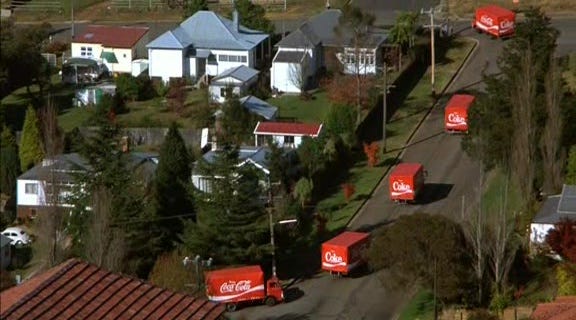◡◶▿ Trap streets of early cinema
🥤 Chemtrails are just watermarks added from outside the simulation.
Dear eternal film students,
I thought to recommend you this interesting post from “ reener ” (?).
Lots to think about, but I'm fixating on a fact that he shared:
"In the earliest movies, when we see the Pathe or Biograph logos in the scenery, this was to deter piracy."
I didn’t know that. Set design as watermark! Trap streets1 of early cinema! Wisps of cigarette smoke forming a trademark!
Consider the implications of the film company’s logo appearing on on-screen cola bottles, aeroplane tails, tombs, and tattoos.
The company embeds itself in the world of the movie (its diegesis). Not as a narrative headline or (in)corporate antagonist but a background presence. Never mentioned by the characters. Noted only by the pirates, feds, and film nerds of our own world.
A fluid, trans-diegetic organisation that not only sells sugary drinks and flights to other parts of the storyworld but maintains offices *outside* of the movie, from where they stamp ownership all over the hero’s environment.
How could he know? How would we know?
Perhaps every studio hires a shadowy figure to provide IP security in-diegesis. To go inside and secure things. Maybe this accounts for plot discrepancies: a conflict of interest between the hero’s narrative and the undercover IP agent’s mission. Her mission as go-between for the (a) real-world and (b) diegetic incarnations of the Pathé Company or Disney or A24.
Anyway, I didn’t know that. I didn’t know that in the earliest movies, the motion picture companies would put their logo in the scenery to deter piracy.
I really, really hope to start sending regular classes again in September. Look out for me in your inbox. And look out for Castle Rock Entertainment in your coffee grounds.
Your Principal,
~Graeme Cole.
📹 Unfound Peoples Videotechnic | Cloud-based filmmaking thought. ☁️
ℹ️ About us | 🦋 Bluesky | 📸 Instagram | 😐 Facebook | 🎞️ Letterboxd | 🌐 Website
“In cartography, a trap street is a fictitious entry in the form of a misrepresented street on a map, often outside the area the map nominally covers, for the purpose of "trapping" potential plagiarists of the map who, if caught, would be unable to explain the inclusion of the "trap street" on their map as innocent.” - Wikipedia




